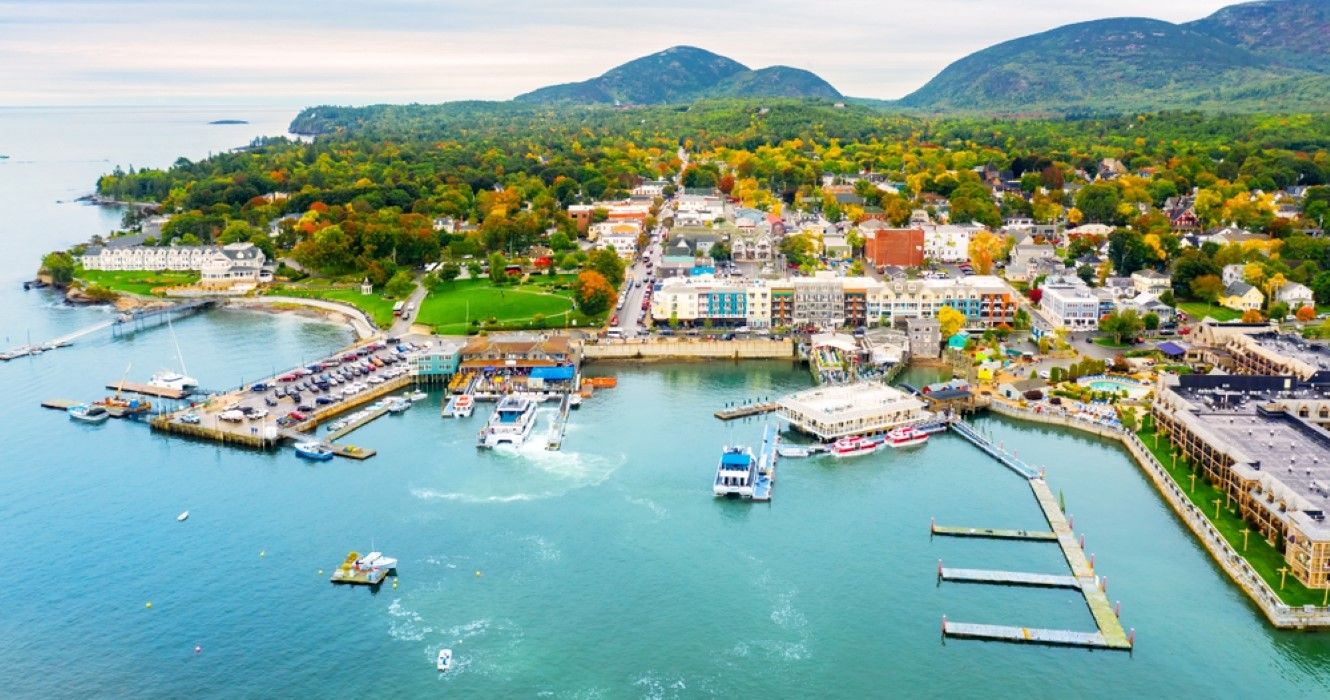Think of Bar Harbor and what probably springs to mind is a colorful lobster shack on the harbor, a sailboat cutting through the water against a deep blue sky, or a refreshing swim at one of the beaches in nearby Acadia National Park. Those scenes and others can easily inspire a summertime visit to this popular coastal Maine town, located on pristine Mount Desert Island.
But the town of Bar Harbor and its environs have plenty to offer during other seasons of the year, when its roads, beaches, and restaurants are uncrowded, and visitors can embrace the area's culture and history.
The town was called Eden when it was founded in 1796 but changed its name to Bar Harbor in 1918. Originally inhabited by Native Americans, the Bar Harbor area in the mid-19th century began to attract artists who captured its landscapes and seascapes on canvas, and the town began to grow. Hotels and cottages were built to accommodate the burgeoning influx of summer visitors, and in 1929 Acadia National Park was established.
Today the park and the town together offer a wide variety of activities for individuals and families not only during the summer tourist season but throughout the whole year.
Off-Season Bar Harbor Means Few Crowds, Cooler Weather
Once the busy tourism season ends in late August, travelers to Bar Harbor can tour the area in a more relaxed environment while taking advantage of many warm-weather activities as well as off-season accommodation rates.
The Bar Harbor Whale Watching Company continues its tours until the second week of October, taking visitors to see marine wildlife as well as views of Acadia National Park and the many islands and lighthouses that dot the coastal waters of the Gulf of Maine.
On land, tour companies offer historical walking tours of Bar Harbor, guided by local experts. Some of the themed walks, hosted by Red Cloak Tours, include Bar Harbor's Haunted History, Maritime History and Mystery, and the Seafood Discover Tour.
And there's a bonus to hiking Acadia National Park in the fall. The 47,000-acre park has 155 miles of trails, and hiking in the fall or spring can be more pleasant, thanks to the cooler temperatures. The trails also are much less crowded, and several trails that are not open in spring or summer due to protection safeguards for nesting peregrine falcons are open to the public in the fall once the chicks have fledged and moved on. Among the trails that reopen by early September are the Precipice Trail and Jordan and the Valley Cove cliffs.
Bar Harbor in the fall is a leaf-peeper's delight, as peak fall colors are seen from mid-September to mid-October each year.
Fall festivals are held each year as well, including the Acadia Night Sky Festival in mid-September. That month also features the annual Bar Harbor Fine Arts Festival, where visitors can peruse original artwork by local, regional, and national artists. It's held in Bar Harbor's downtown.
Come winter; visitors can hike in Acadia National Park with the right equipment, such as traction footwear and trekking poles since the trails can become icy and snow-packed. The park's carriage roads are valued for cross-country skiing and snowshoeing during winter.
Acadia National Park Is The Treasure Of Down East Maine
Bar Harbor is the gateway to Acadia National Park, with its 27 miles of historic roads, 158 miles of trails, and 45 miles of carriage roads. Private vehicles pay a $30 fee to enter the park, and the admission is good for seven days. Acadia National Park also is home to Cadillac Mountain, which stands at 1,530 feet and is the highest point along the northeast seacoast. The mountain officially lies within the town of Bar Harbor, which can be seen from atop the mountain.
No visit to Down East Maine is complete without seeing the view from the top of Cadillac Mountain, and its popularity requires a reservation through the national park, which charges a separate admission fee per vehicle. The mountain is open to the public from late May to mid-October.
Visitors begin the 3.5-mile climb to the top of Cadillac Mountain along Summit Road, and there are observation points along the way offering viewing opportunities.
Walkers and hikers who visit the national park have a wide choice of trails that vary by length. Some of the most popular hikes include the 1.7-mile Great Head Trail, a two- to four-hour trek that takes hikers to a coastal headland and some wooded areas. Along the route, walkers can see the ruins of a 20th-century tea house.
The 2.2-mile Ocean Path Trail, another well-used route, offers ocean views, granite slabs, and rocky cliffs and is an access point to Thunder Hole, a favorite rocky inlet, and to the 110-foot-high Otter Cliff, one of the highest Atlantic coastal headlands.
Hikers looking for a longer trip can take the Gorham Mountain Loop, a 3.5-mile trail featuring panoramic views of Mount Desert Island, Frenchman Bay, and many islands.

